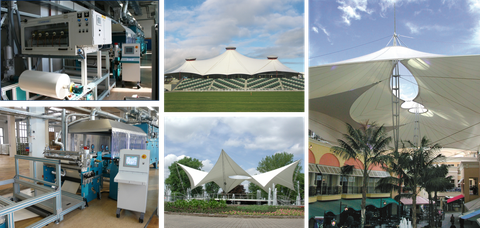Textile membranes and architecture

Multifunctional coating plant (left), application examples for textile high-performance membranes as architecturally and artistically sophisticated, modern, and ultra-lightweight canopies (right)
Textile membranes are often used in architecture to realize large, unsupported roof areas, reduce their weight to a minimum and focus the design on the acting snow and wind loads. To this end, very thin, skin-like materials like foils or woven and warp-knitted textiles with or without coatings are used, which are easy to plastically shape, and can only be loaded statically with tension.
The textile-technical and textile-technological design of membranes requires a great degree of experience and know-how, as the entire application profile of the semi-finished textile product is determined by the statics of the membrane. Here, edge geometry and formation, as well as shape and load transfer are determined. Membrane constructions exhibit extensive deformations under loads and have high requirements of connection points, which have to be designed textile and assembly-technically.
The production of textile membranes is based on a set geometry by means of CAD cutting models reflecting the planned pre-tension state with due regard to the elongation behavior of the selected material. The resulting individual steps are applied to the raw material with the help of computers. Alternatively, CNC cutting plotters are used to directly prepare the material before subsequent joining.
The seminal orientation of membrane technology for increasing requirements with regard to growing dimensions to be bridged, the increasingly complex shaping and growing strains are coupled with the continuous development of modern textile production methods, which is a core competence of the ITM. High-performance membranes with force-path-adjusted and spread fiber layers, modularly integrated coating, and subsequent machine-internal cutting are the peak of membrane construction. Currently, the simulation and modeling of textile membranes, and their automated assembly, are being researched most intensely.
Contact person:
 © Mirko Krziwon
© Mirko Krziwon
Ms Dr.-Ing. Iris Kruppke
Research Group Leader Textile Chemistry & Finishing
Send encrypted email via the SecureMail portal (for TUD external users only).
Visiting address:
Breitscheidstr. 78, House D, Room 1.1.10
01237 Dresden
